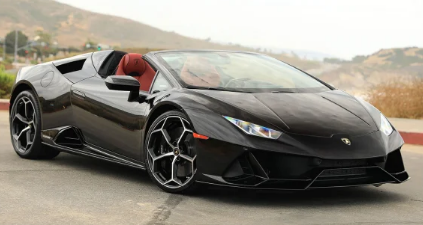The Huracán has gone on to become the best-selling model in Lamborghini’s 56-year history since its debut at the 2014 Geneva Auto Show. Although the company’s “entry level” sports car will likely be replaced in the near future by the Urus sport-utility, the Huracán’s role to the current success of the illustrious Italian brand cannot be overstated.

A constant stream of variations over the previous five years must be acknowledged, with the agile Performante standing as the pinnacle of contemporary supercar performance at the time of its introduction. The Performante, however, had cutting edge technology, such as the Aerodinamica Lamborghini Attiva active aero-vectoring system, while other elements of the Huracán’s design were beginning to seem dated.
In an effort to maintain the Huracan’s momentum, Lamborghini unveiled the Evo coupe earlier this year. This mid-cycle update gave the normal Huracán model Performante components as well as a few additional tricks.
Despite the Huracán’s abilities on a road course, many of them will never set foot on a racetrack in their lifetime. In reality, Lamborghini road cars have always been more alluring for their ability to make a statement than for their ability to run quick lap times. The street is where these vehicles will spend the most of their time, therefore they must genuinely shine there. In light of this, the Huracán Evo Spyder might be the purest supercar experience currently available.
Outside And Inside
When the opportunity arises, it is certainly worth doing the Evo Spyder’s soft top stow, which just takes 17 seconds and can be done at speeds of up to 31 mph. The unhindered link between your ears and the audio of the engine is one of the natural advantages of topless sports cars, and this brings out a number of the Evo Spyder’s advantages.
A naturally aspirated 5.2-liter V10 with 631 horsepower and 443 pound-feet of torque is hidden right behind the passenger area. The high-winding mill, which appears to be untouched from its setup in the Performante, howls to its 8000 RPM redline through a new center-exit dynamic exhaust system, which alters its volume and character depending on the drive mode and throttle position.
When equipped with an all-wheel drive system and a seven-speed dual clutch gearbox, the Evo Spyder can accelerate from 0 to 62 mph in in 3.1 seconds. That much speed will quickly cause the surroundings to blur, but it’s important to note that the Spyder loses two tenths of a second to its siblings with closed roofs since the additional 256 pounds of structural reinforcement necessary causes its dry weight to increase to an even 3400 pounds.
The Huracán’s turning radius is significantly decreased by rear steering, making it simpler to maneuver through confined spaces.
Similar to the coupe, the Evo Spyder gains from a number of aerodynamic improvements over the LP610-4 Spyder it replaces. Significant changes to the front fascia and splitter, as well as a new integrated rear spoiler, are among the highlights. According to Lamborghini, these changes increase downforce and aerodynamic efficiency by more than five times compared to the previous generation. The Spyder features a pair of vertical fins right behind the seatbacks that taper downward toward the engine cover to give the car’s design more consistency. From an aesthetic perspective, it equates to the most angular Huracán ever.
The interior modifications are less noticeable, but the center stack’s new 8.4-inch touchscreen infotainment system is a pleasant improvement. The absence of a real volume knob is an irritating oversight, as we noted in our initial drive of the coupe, but overall, the system’s quick responsiveness, crisp graphics, and genuinely helpful gesture controls more than make up for it. For instance, changing the volume from any menu screen without skipping a beat can be done by using two fingers to swipe up or down on the screen. The sound is no match for the engine’s siren scream when the top is down, while being less accurate than a typical knob, but we quickly got used to it.
Driving the vehicle
Another important goal of the Evo upgrade was to improve the handling performance of the basic Huracán. While Lamborghini’s clever new predictive traction and stability control systems that make up Lamborghini Dinamica Veicolo Integrata (LDVI) probably won’t be much use to most drivers on public roads, we found that some other dynamic changes produced benefits that were greater in normal driving than they are on race tracks.
When driving the coupe around Willow Springs earlier this year, we found that we needed to adjust our inputs to the Evo’s new four-wheel steering system because the car might occasionally seem jittery and darty due to its willingness to shift direction. On public roads, however, this is much less of a problem, as the rear-steering noticeably reduces the car’s turning radius, making it simpler to maneuver the Huracán through narrow spaces, such as crowded parking lots or mountain slopes.
The Evo Spyder, like all Huracán models, has three distinct driving modes: Strada, Sport, and Corsa. These modes are selected with a toggle switch on the steering wheel. Although each gives the Huracán a unique personality, it would have been lovely to have had a personalized choice like the Aventador’s “Ego” mode.
The Huracán Evo Spyder delivers on what its wild appearance promised, and it does so without penalizing the driver.
As it is, there is no way to, for example, combine Corsa’s exhaust mode with Strada’s automated shifting and tight suspension. The majority of the time, sport provides a satisfactory middle ground, but occasionally its general sense of attentiveness doesn’t exactly fit the circumstance.
Contrarily, Strada calms the vehicle both literally and figuratively, taming the V10’s snarl and calming the chassis’ reactions. It can get a little much at times; on numerous occasions, we discovered that the transmission will not downshift into a gear lower than sixth without applying the brakes completely. When a driver is only attempting to pass slower traffic, doing so would almost always result in a downshift to third or second gear and far more drama than they presumably want. The easiest fix we found was to just shift into the correct gear with a few pulls of the left shift paddle, make the pass, and then wait a few seconds for the gearbox to automatically switch back to automatic.
How DT Would Set This Car Up
When the roof is closed, the Evo Spyder is less enjoyable for taller drivers to drive even though it is still a joy to do so with the top down. Grand touring seats are standard on Evo models, but racing bucket seats from the Performante are an option that are positioned lower in the vehicle and give the driver extra headroom. If we were the ones signing on the dotted line, we’d probably choose that option.
In terms of appearance, the matte black Loge 20-inch forged wheel would look great with the not-so-subtle Arancio Xanto paint. For those rare instances when music might take precedence over the glorious bark of the V10, even though we probably wouldn’t be able to hear it most of the time, we’d also choose the Lamborghini Sensonum premium audio system. The optional raising mechanism, which temporarily lifts the front end of the car to negotiate steep driveways and the like, is virtually required given how low the front splitter sits.
The Development Of The Super Sports Vehicle
Some people complain about the rising standard of decency offered by supercars in recent years. Although, at the end of the day, a supercar isn’t worth much if you don’t truly want to drive it, we can’t help but question if all the wailing and gnashing of teeth comes from a place of experience or fiction.
The Huracán Evo Spyder delivers on what its wild appearance promised, yet it does so without penalizing the driver. You may turn up the wick at a moment’s notice to make delighted onlookers smile (we did) or chop up a decent section of road (we definitely did that too). The Evo is a more practical alternative for routine day-to-day tasks because it can be as submissive as a standard commuter car when you ask it to.
However, the cost of such a dichotomy shouldn’t come as a surprise. The basic price of the 2020 Huracán Evo Spyder is $287,400, but our tester came in at $339,845, including a $3695 shipping fee and $14,000 for the gorgeous Nero Granatus paint.
That puts the Huracán Evo Spyder on par with powerful vehicles like the Ferrari 488 Pista Spider and McLaren 720S Spider, both of which deliver more horsepower at the expense of a less stirring turbocharged audio.
However, the heart, not the mind, finally decides on such matters. Each of the three is an outstanding mid-engined performance vehicle with a distinctive approach to the supercar concept. That probably won’t help potential buyers make their decision, but rest assured that if this Lamborghini roadster ends up in your garage, you most likely won’t regret it.
You can also check 2020 Porsche Cayenne Turbo S E-Hybrid first drive review







